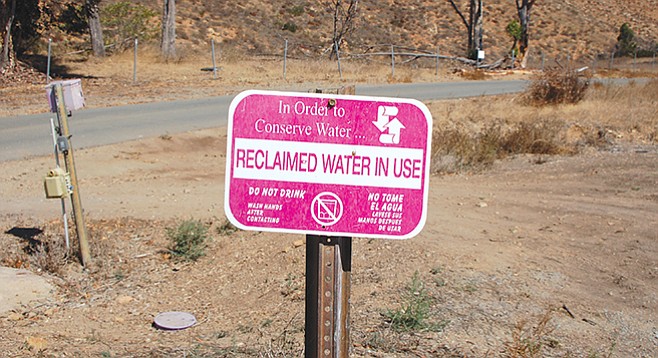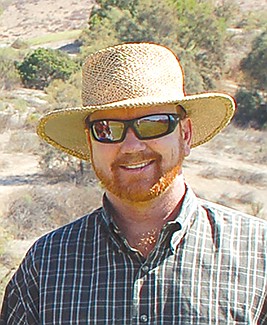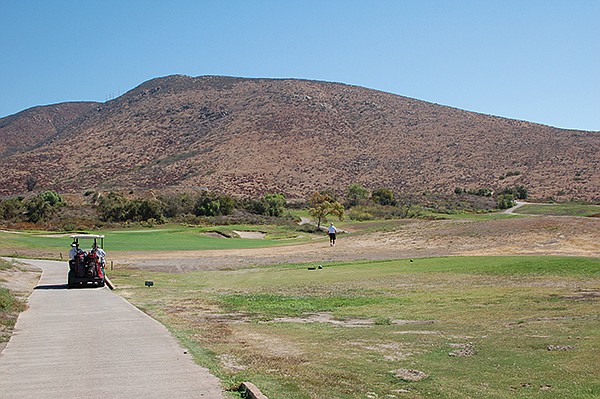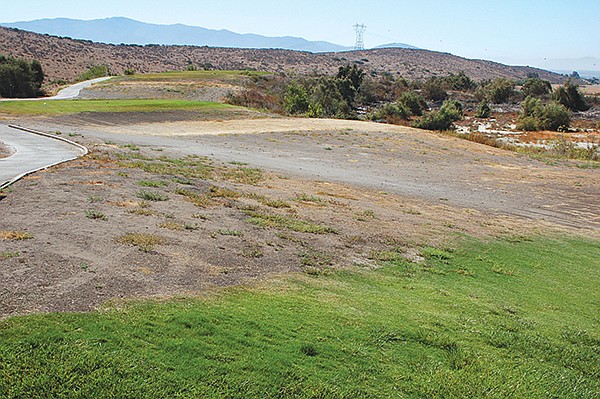 Facebook
Facebook
 X
X
 Instagram
Instagram
 TikTok
TikTok
 Youtube
Youtube

- A heap of broken images, where the sun beats,
- And the dead tree gives no shelter, the cricket no relief,
- And the dry stone no sound of water. Only
- There is shadow under this red rock,
- (Come in under the shadow of this red rock),
- And I will show you something different from either
- Your shadow at morning striding behind you
- Or your shadow at evening rising to meet you;
- I will show you fear in a handful of dust.
— T.S. Eliot
Five years into the California drought and T.S. Eliot is sounding more like a prophet than a poet. As I drove down SR-125 southbound on my way to the Salt Creek Golf Course, Elliot’s stanzas rolled through my head.
“A heap of broken images, where the sun beats.... I will show you fear in a handful of dust.”
That sounded about right, based on the scenery along the toll-road corridor. As I approached the course I glimpsed distant spots of green being swallowed by a sea of desert browns. I swallowed to chase away the image of the parched land that had made its way to my throat.
Pulling into the parking lot, I joined the few dozen cars huddled to one side grasping for the shade of a few trees. This eastern area of Chula Vista has been baked brown like a French loaf left in the oven for too long.
In spite of the heat, folks were golfing their Titleists around the course. For the uninitiated, golf makes no sense whatsoever.
Those who despise golf will despise it regardless of the environmental circumstances. Add a drought and water shortage, and those for whom golf is “elitist” have another sword to swing.
Likewise, those who would subject themselves to this tyrannical activity make no sense.
A golfer looks forward to the next round with the anticipation of a four-year-old going to Disneyland for the first time. Sleep is light the night before. The alarm sounds and there is no grogginess — there is only the unmistakable motion of somebody getting out of bed with purpose.
About an hour and a half later and five holes into the course, that same giddy toddler has been corrupted by the sport into a curmudgeon of heroic proportions. A companion might throw a compliment their way, such as, “Nice putt,” at the conclusion of a difficult hole.
With a voice coated in bile, the common golfer will reply, “Thanks. But that putt was like whipped cream on dog shit.” But every golfer likes the whipped cream, needs the whipped cream, lives for the whipped cream.
Can we, the golfer and the nongolfer, agree that the activity is inexplicable? We just have different reasons for why we hate it. Yet the fact remains, drought or no drought, golfers are going to golf and nongolfers are going to think it’s pointless.
I wasn’t at Salt Creek to golf; I was there to talk about water use with the head groundskeeper...Rob Browns. It’s a touchy subject for golf courses. How do they justify using the amount of water to keep a golf course green in the midst of a historic drought? The United States Golf Association states, “Golf courses in hot, dry climates may require as much as 6 acre-feet of water per acre per year.” That’s 1.95 million gallons, or roughly the amount of water used by 45 Southern Californians in a year.
Browns’s demeanor was as bright as his complexion was ruddy. He wore a floppy hat, sunglasses, a long-sleeved shirt, and pants. Browns is no fool: the less sun, the better.

Browns is facing the same challenge that all groundskeepers are facing in California. The price of water has more than doubled since he has been at Salt Creek. As we slid into the groundskeeping cart, Browns said, “For courses like ours who need to buy water, it’s a major line item on the budget. We work with a weather station which tells us exactly how much the course needs and then we put that amount of water out — actually less because of the price of the water.”
A weather station tells golf courses how much water to use? I asked Browns for an explanation.
“There’s a formula called the evapotranspiration rate which determines how much water evaporates out of the soil each day depending on the heat, humidity, wind, solar radiation — it’s a pretty complicated formula. That information is available to anyone. The system is called the California Irrigation Management Information System. It’s free to look up.”
We sat in silence as I digested the idea of measuring solar radiation and its effects on irrigation on a daily basis. Sol Invictus truly is the ruler of this planet. The cart continued to bump along the path. Nearby, Mount Miguel frowned down at the golf course huddled up against his broad feet.
I broke my reverie by asking about the acreage of the course.
“The golf course is about 120 acres and we’re watering about 70 acres right now. We used to water about 90 acres — oh, I love these guys.”
As we rounded a corner, three figures were observing the tee box while a pleasant-looking woman supervised, the lanyard around her neck indicating her position of responsibility for the trio. We stopped to say hi.
I asked the supervisor, Marni Braithwaite, what was going on. “This is part of the extended transition program at Eastlake High School. It’s for kids with disabilities, ages 18 to 22. We’re helping them build job skills after they graduate high school.”
The program has been partnered with Salt Creek for about two years. I shook the hands of the three young men and asked if I could take a photograph.
Browns and I continued our journey. We passed dried-up ponds, long stretches of rough terrain, and the playability of the course became our topic.
Playability has always been a key element to any golf course in any climate. How does the course play? What size are the greens? How wide are the fairways? How many forced carries are there? These are playability issues.

The forced carry has become a popular feature because of the price of water during the past several years. A forced carry means the ball must fly over an area that is unplayable. Forced carries traditionally are water, but, you know, drought. More and more it is becoming a feature of the terrain.
At Salt Creek, Browns has partnered with arborists and lets them deposit their wood chips on the course. The chips are then arranged as forced carries across sections of the fairways that have been allowed to die.
Playability versus water usage is an issue because golfers won’t go to a course that has become unplayable. At least unplayable for the average to below average golfer. The greens are always a priority on a golf course, or at least they should be. Browns has worked closely with the water district to reallocate water from the rough and fairways to the greens.

“I can keep the fairways fine with ten minutes of water per day, but I can’t keep the greens alive with that. Golf is on the cutting edge of water issues because for a lot of courses it’s the bottom line. Some courses have sensors in the ground which record the exact level of moisture. The least amount of water for the best product is pretty much the philosophy and you don’t want to play a wet golf course.”
It’s true. I don’t. There is nothing worse in the sport than a wet course.
“We try to use just the right amount of water to keep the plant in optimal health. You don’t want to over water. We get a lot of roll out here because the course is so dry. People love it. The ball just rolls and rolls and rolls.”
Browns went on to discuss wetting agents and green dye. Golf courses use wetting agents to make sure the water is being absorbed deep into the ground instead of staying near the surface where it can more easily evaporate. Without the wetting agents, the ground can even repel the water because it has become so dry.
Green dye? Oh, yes. Some of the fairways at Salt Creek would be brown without it.
Browns and I completed our expedition with a quick view of the driving range. This was not the luscious field of dreams of driving ranges past. This was the field of an ancient battle fought on the surface of Mars as the red planet breathed its last.
The Salt Creek driving range used to be 25 acres of grass being watered for no reason except aesthetics. Browns broke down the decision to go brown on the range.
“The only benefit to having grass is that the range balls last a little bit longer because they don’t get scratched up. The cost of water versus the cost of buying golf balls isn’t even close. Water bills are hundreds of thousands of dollars. Range balls are $5 per dozen. It’s an easy equation.”
Browns refused to provide an exact figure for Salt Creek’s water bill.
Before I left, Browns mentioned a turf-reduction incentive that the water district had offered to golf courses. Salt Creek had found out about the program too late to take advantage of it. I asked if any courses had.
The Rancho Santa Fe Golf Club, a members-only establishment, had taken advantage of the water district’s generous offer — and how. The program offered $2 to $3 for every square foot of turf removed.
Rancho Santa Fe removed 19 acres of turf. There are 43,560 square feet in an acre. We’ll use the $2 figure, which means each acre removed was worth $87,120. Now multiply by 19 and it comes out to $1,655,280. Rancho Santa Fe is also saving up to 15 million of gallons of water per year with the move.
So, the rich do get richer. The water district is looking at lifetime caps to the rebates so they don’t run out of funds.
Before we get too excited about this subsidy, those acres will never be watered again. The 15 million gallons per year is a permanent water saving. The water district is incentivizing conservation against the continuation of this drought and in preparation for droughts to come.
The 865 golf courses in California use about 1 percent of the state’s water, according to the California Alliance for Golf. The courses are estimated to generate north of $13 billion per year for the economy of the Golden State. Golf is likely here to stay, unless things get a whole lot worse But between recession (which has lowered the number of players) and drought (which has made water more expensive) the industry is contracting. Nationwide, there were 30.6 million golfers in 2003; that number had fallen to 24.7 million in 2014, according to the National Golf Foundation. Bloomberg.com reports than more than 800 courses have closed nationwide, In San Diego County, Carmel Highlands, Escondido Country Club, San Luis Rey Downs in Bonsall, and Fallbrook Golf Club have all closed. Riverwalk Golf Club, just north of Interstate 8 and west of SR-163 in Mission Valley, is slated to be the site of a 4000-unit condominium development.
Salt Creek, meanwhile, hangs on. The course, which offers $25 rounds after noon on weekdays and $40 on weekends, generally receives positive reviews on golfadvisor.com, though dry fairways are mentioned the most. The most recent reviewer, as of this writing, complained, “THIS COURSE is in desperate NEED of WATER!!!!!!”


- A heap of broken images, where the sun beats,
- And the dead tree gives no shelter, the cricket no relief,
- And the dry stone no sound of water. Only
- There is shadow under this red rock,
- (Come in under the shadow of this red rock),
- And I will show you something different from either
- Your shadow at morning striding behind you
- Or your shadow at evening rising to meet you;
- I will show you fear in a handful of dust.
— T.S. Eliot
Five years into the California drought and T.S. Eliot is sounding more like a prophet than a poet. As I drove down SR-125 southbound on my way to the Salt Creek Golf Course, Elliot’s stanzas rolled through my head.
“A heap of broken images, where the sun beats.... I will show you fear in a handful of dust.”
That sounded about right, based on the scenery along the toll-road corridor. As I approached the course I glimpsed distant spots of green being swallowed by a sea of desert browns. I swallowed to chase away the image of the parched land that had made its way to my throat.
Pulling into the parking lot, I joined the few dozen cars huddled to one side grasping for the shade of a few trees. This eastern area of Chula Vista has been baked brown like a French loaf left in the oven for too long.
In spite of the heat, folks were golfing their Titleists around the course. For the uninitiated, golf makes no sense whatsoever.
Those who despise golf will despise it regardless of the environmental circumstances. Add a drought and water shortage, and those for whom golf is “elitist” have another sword to swing.
Likewise, those who would subject themselves to this tyrannical activity make no sense.
A golfer looks forward to the next round with the anticipation of a four-year-old going to Disneyland for the first time. Sleep is light the night before. The alarm sounds and there is no grogginess — there is only the unmistakable motion of somebody getting out of bed with purpose.
About an hour and a half later and five holes into the course, that same giddy toddler has been corrupted by the sport into a curmudgeon of heroic proportions. A companion might throw a compliment their way, such as, “Nice putt,” at the conclusion of a difficult hole.
With a voice coated in bile, the common golfer will reply, “Thanks. But that putt was like whipped cream on dog shit.” But every golfer likes the whipped cream, needs the whipped cream, lives for the whipped cream.
Can we, the golfer and the nongolfer, agree that the activity is inexplicable? We just have different reasons for why we hate it. Yet the fact remains, drought or no drought, golfers are going to golf and nongolfers are going to think it’s pointless.
I wasn’t at Salt Creek to golf; I was there to talk about water use with the head groundskeeper...Rob Browns. It’s a touchy subject for golf courses. How do they justify using the amount of water to keep a golf course green in the midst of a historic drought? The United States Golf Association states, “Golf courses in hot, dry climates may require as much as 6 acre-feet of water per acre per year.” That’s 1.95 million gallons, or roughly the amount of water used by 45 Southern Californians in a year.
Browns’s demeanor was as bright as his complexion was ruddy. He wore a floppy hat, sunglasses, a long-sleeved shirt, and pants. Browns is no fool: the less sun, the better.

Browns is facing the same challenge that all groundskeepers are facing in California. The price of water has more than doubled since he has been at Salt Creek. As we slid into the groundskeeping cart, Browns said, “For courses like ours who need to buy water, it’s a major line item on the budget. We work with a weather station which tells us exactly how much the course needs and then we put that amount of water out — actually less because of the price of the water.”
A weather station tells golf courses how much water to use? I asked Browns for an explanation.
“There’s a formula called the evapotranspiration rate which determines how much water evaporates out of the soil each day depending on the heat, humidity, wind, solar radiation — it’s a pretty complicated formula. That information is available to anyone. The system is called the California Irrigation Management Information System. It’s free to look up.”
We sat in silence as I digested the idea of measuring solar radiation and its effects on irrigation on a daily basis. Sol Invictus truly is the ruler of this planet. The cart continued to bump along the path. Nearby, Mount Miguel frowned down at the golf course huddled up against his broad feet.
I broke my reverie by asking about the acreage of the course.
“The golf course is about 120 acres and we’re watering about 70 acres right now. We used to water about 90 acres — oh, I love these guys.”
As we rounded a corner, three figures were observing the tee box while a pleasant-looking woman supervised, the lanyard around her neck indicating her position of responsibility for the trio. We stopped to say hi.
I asked the supervisor, Marni Braithwaite, what was going on. “This is part of the extended transition program at Eastlake High School. It’s for kids with disabilities, ages 18 to 22. We’re helping them build job skills after they graduate high school.”
The program has been partnered with Salt Creek for about two years. I shook the hands of the three young men and asked if I could take a photograph.
Browns and I continued our journey. We passed dried-up ponds, long stretches of rough terrain, and the playability of the course became our topic.
Playability has always been a key element to any golf course in any climate. How does the course play? What size are the greens? How wide are the fairways? How many forced carries are there? These are playability issues.

The forced carry has become a popular feature because of the price of water during the past several years. A forced carry means the ball must fly over an area that is unplayable. Forced carries traditionally are water, but, you know, drought. More and more it is becoming a feature of the terrain.
At Salt Creek, Browns has partnered with arborists and lets them deposit their wood chips on the course. The chips are then arranged as forced carries across sections of the fairways that have been allowed to die.
Playability versus water usage is an issue because golfers won’t go to a course that has become unplayable. At least unplayable for the average to below average golfer. The greens are always a priority on a golf course, or at least they should be. Browns has worked closely with the water district to reallocate water from the rough and fairways to the greens.

“I can keep the fairways fine with ten minutes of water per day, but I can’t keep the greens alive with that. Golf is on the cutting edge of water issues because for a lot of courses it’s the bottom line. Some courses have sensors in the ground which record the exact level of moisture. The least amount of water for the best product is pretty much the philosophy and you don’t want to play a wet golf course.”
It’s true. I don’t. There is nothing worse in the sport than a wet course.
“We try to use just the right amount of water to keep the plant in optimal health. You don’t want to over water. We get a lot of roll out here because the course is so dry. People love it. The ball just rolls and rolls and rolls.”
Browns went on to discuss wetting agents and green dye. Golf courses use wetting agents to make sure the water is being absorbed deep into the ground instead of staying near the surface where it can more easily evaporate. Without the wetting agents, the ground can even repel the water because it has become so dry.
Green dye? Oh, yes. Some of the fairways at Salt Creek would be brown without it.
Browns and I completed our expedition with a quick view of the driving range. This was not the luscious field of dreams of driving ranges past. This was the field of an ancient battle fought on the surface of Mars as the red planet breathed its last.
The Salt Creek driving range used to be 25 acres of grass being watered for no reason except aesthetics. Browns broke down the decision to go brown on the range.
“The only benefit to having grass is that the range balls last a little bit longer because they don’t get scratched up. The cost of water versus the cost of buying golf balls isn’t even close. Water bills are hundreds of thousands of dollars. Range balls are $5 per dozen. It’s an easy equation.”
Browns refused to provide an exact figure for Salt Creek’s water bill.
Before I left, Browns mentioned a turf-reduction incentive that the water district had offered to golf courses. Salt Creek had found out about the program too late to take advantage of it. I asked if any courses had.
The Rancho Santa Fe Golf Club, a members-only establishment, had taken advantage of the water district’s generous offer — and how. The program offered $2 to $3 for every square foot of turf removed.
Rancho Santa Fe removed 19 acres of turf. There are 43,560 square feet in an acre. We’ll use the $2 figure, which means each acre removed was worth $87,120. Now multiply by 19 and it comes out to $1,655,280. Rancho Santa Fe is also saving up to 15 million of gallons of water per year with the move.
So, the rich do get richer. The water district is looking at lifetime caps to the rebates so they don’t run out of funds.
Before we get too excited about this subsidy, those acres will never be watered again. The 15 million gallons per year is a permanent water saving. The water district is incentivizing conservation against the continuation of this drought and in preparation for droughts to come.
The 865 golf courses in California use about 1 percent of the state’s water, according to the California Alliance for Golf. The courses are estimated to generate north of $13 billion per year for the economy of the Golden State. Golf is likely here to stay, unless things get a whole lot worse But between recession (which has lowered the number of players) and drought (which has made water more expensive) the industry is contracting. Nationwide, there were 30.6 million golfers in 2003; that number had fallen to 24.7 million in 2014, according to the National Golf Foundation. Bloomberg.com reports than more than 800 courses have closed nationwide, In San Diego County, Carmel Highlands, Escondido Country Club, San Luis Rey Downs in Bonsall, and Fallbrook Golf Club have all closed. Riverwalk Golf Club, just north of Interstate 8 and west of SR-163 in Mission Valley, is slated to be the site of a 4000-unit condominium development.
Salt Creek, meanwhile, hangs on. The course, which offers $25 rounds after noon on weekdays and $40 on weekends, generally receives positive reviews on golfadvisor.com, though dry fairways are mentioned the most. The most recent reviewer, as of this writing, complained, “THIS COURSE is in desperate NEED of WATER!!!!!!”
Comments